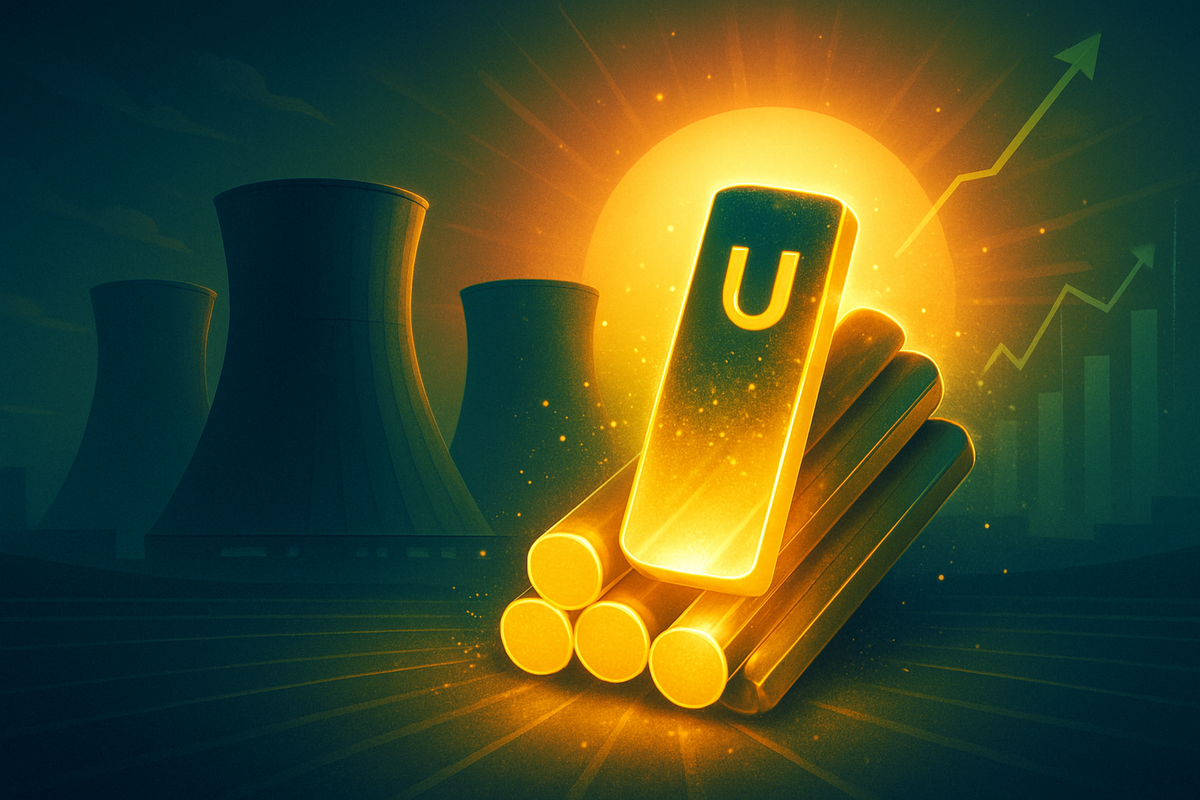
The uranium market is currently experiencing an unprecedented surge, with spot prices reaching their highest levels of the year by October 2025. This significant uptick, driven by a widening structural supply deficit and a global push towards nuclear energy, is sending ripples across the energy sector. The immediate implication is a deepening procurement crisis for nuclear utilities, who face the challenge of securing long-term contracts at elevated prices amidst ambitious expansion plans for nuclear power worldwide.
This rally underscores a pivotal moment for nuclear energy, as nations increasingly turn to it for climate goals and energy security. However, the current supply constraints, exacerbated by production delays from major miners and geopolitical factors, are creating a tight market. This situation is compelling increased investment in exploration and mining, though new supply will take years to materialize, setting the stage for continued volatility and strategic shifts in the global energy landscape.
The Unfolding Uranium Squeeze: A Deep Dive into Market Dynamics
Uranium spot prices concluded September 2025 at an impressive $82.63 per pound, marking the highest point observed this year and a substantial 28.7% increase from the March 2025 low of $64.23 per pound. This upward trajectory continued into October, with futures on October 2, 2025, hovering around $83.10 per pound, just shy of the near-one-year high of $83.50 reached on September 25. This remarkable price action is not merely speculative; it is firmly rooted in a widening structural supply-demand imbalance and robust interest from financial players.
The timeline leading to this moment has seen a consistent tightening of the market. Throughout 2025, annual reactor demand, estimated at approximately 180 million pounds, has consistently outstripped primary uranium production, which stands around 130 million pounds. This creates a significant 28% shortfall, a deficit that analysts widely expect to persist, at minimum, through 2026. Key players in the market, such as the Sprott Physical Uranium Trust (TSX: U.UN) and the UK's Yellow Cake (LSE: YCA), have been actively acquiring large quantities of physical uranium, further exacerbating the supply squeeze due to the commodity's relatively thin trading volume.
Adding to the supply woes are significant production constraints and delays from major producers. Canadian giant Cameco (TSX: CCO) (NYSE: CCJ) notably reduced its annual production guidance by 19% due to expansion setbacks at its crucial McArthur River mine. Similarly, Kazakhstan's Kazatomprom (LSE: KAP), the world's largest uranium producer, announced a 10% output cut for 2026. These operational delays, coupled with rising input costs and regulatory hurdles, have pushed the average global production cost to $40-$60 per pound, with new mine developments requiring $65-$75 per pound to be economically viable. The initial market reaction has been overwhelmingly bullish, with the Northshore Global Uranium Mining Index appreciating approximately 45% in 2025, and analysts like Bank of America revising their 2025 forecast to $90-$100 per pound, with projections soaring to $135 in 2026.
Winners and Losers: Corporate Impacts of the Uranium Boom
The surge in uranium prices is creating a clear delineation between potential winners and losers within the energy and mining sectors, profoundly impacting their operational strategies and financial outlooks. Uranium mining companies, particularly those with existing production or advanced development projects, stand to be the primary beneficiaries. Companies like Cameco (TSX: CCO) (NYSE: CCJ), despite its production guidance reduction, and Kazatomprom (LSE: KAP) will see increased revenues and profitability from their uranium sales, albeit with the challenge of maximizing output. Junior miners and exploration companies, such as NexGen Energy (TSX: NXE) (NYSE: NXE) and Denison Mines (TSX: DML) (NYSE: DNN), are experiencing renewed investor interest and increased capital inflows, enabling them to fund exploration and mine restart studies. Indeed, public uranium mining and development companies have collectively raised over $1.2 billion in new equity capital in 2025. These companies are poised to capitalize on the higher prices, making previously uneconomical projects viable and accelerating their path to production.
Conversely, nuclear utilities and power generators face significant headwinds. Companies operating nuclear power plants, such as Constellation Energy (NASDAQ: CEG) in the US or EDF (EPA: EDF) in Europe, are grappling with a deepening "contracting crisis." An estimated 25-30% of their 2025 uranium requirements remain uncontracted, escalating to 35-40% for 2026, and a staggering nearly 70% by 2027-2028. This forces them into the spot market or into securing long-term contracts at substantially higher prices, directly impacting their operational costs and potentially squeezing profit margins. While the long-term demand for nuclear power is strong, the immediate challenge of securing fuel at competitive prices is a critical concern for these entities.
Furthermore, companies involved in the nuclear fuel cycle, such as enrichment and fabrication services, may see mixed effects. While higher uranium prices could eventually translate to increased demand for their services as more reactors come online, the immediate pressure on utilities' fuel procurement budgets might lead to cost-cutting elsewhere. The geopolitical realignment of supply chains also presents both opportunities and challenges; companies in Western jurisdictions, like those involved in the US strategic uranium reserve initiative, may see increased demand and government support, while those reliant on historically concentrated sources like Russia might face diversification pressures and supply chain disruptions. The entire sector is now strategically evaluating long-term supply agreements and hedging strategies to mitigate future price volatility.
Broader Significance: A Catalyst for Nuclear's Resurgence
The current surge in uranium prices is not an isolated event but rather a powerful manifestation of broader industry trends signaling a global "nuclear power renaissance." This event fits squarely into the overarching narrative of nations aggressively pursuing ambitious climate goals, striving for enhanced energy security in a volatile geopolitical landscape, and meeting the burgeoning electricity demands from new, energy-intensive sectors like artificial intelligence and data centers. The International Atomic Energy Agency (IAEA) has dramatically revised its forecast, now predicting a 2.6-times increase in new nuclear capacity, from 377 GW in 2024 to an astounding 992 GW by 2050. This long-term demand outlook provides a robust foundation for sustained high uranium prices.
The ripple effects of this price surge are profound, impacting competitors, partners, and the regulatory environment. For traditional fossil fuel power generators, the rising cost of nuclear fuel, while significant, is still often outweighed by the environmental and carbon pricing advantages of nuclear power, potentially making nuclear an even more attractive alternative. Partners in the nuclear supply chain, from component manufacturers to construction firms, will likely see increased investment and project opportunities as new reactors and Small Modular Reactors (SMRs) are planned and built. Regulatory bodies worldwide are also being pressured to streamline licensing processes and provide financial incentives to accelerate nuclear development, recognizing its critical role in decarbonization. The US, for instance, has announced plans to boost its strategic uranium reserve, favoring Western jurisdictions and reshaping global sourcing strategies, which has significant policy implications for international trade and alliances.
Historically, uranium markets have experienced periods of rapid price appreciation, notably in 2007, driven by similar supply-demand imbalances and growing interest in nuclear power. While the current rally shares some characteristics with past booms, the context of aggressive global decarbonization targets and the mature state of nuclear technology (including the advent of SMRs) suggests a more sustainable and structurally driven uplift rather than purely speculative fervor. Geopolitical tensions, particularly regarding the diversification of uranium supply chains away from concentrated sources like Russia, and events such as the Niger coup, have amplified price volatility, underscoring the strategic importance of secure and diversified uranium supplies. This current market dynamic serves as a stark reminder of the delicate balance between energy security, environmental goals, and raw material availability.
What Comes Next: Navigating the Future of Uranium and Nuclear Energy
Looking ahead, the uranium market and the nuclear energy sector face a period of dynamic transformation, characterized by both significant opportunities and formidable challenges. In the short term, continued price volatility is almost certain as the structural supply deficit persists. Analysts largely remain bullish, with many forecasting prices to exceed $100 per pound by late 2025 or 2026, and some even projecting $150-$200 per pound under accelerated demand scenarios. This sustained high price environment will continue to incentivize increased exploration and development activities by uranium miners, though the long lead time (typically 7-10 years from discovery to production) means these efforts will not alleviate the near-term supply crunch. Nuclear utilities will continue to grapple with securing long-term contracts, potentially leading to innovative procurement strategies and increased vertical integration attempts.
In the long term, the landscape will be shaped by the success of new mining projects coming online and the accelerated deployment of new nuclear capacity, particularly Small Modular Reactors (SMRs). SMRs are increasingly viewed as a vital component of future nuclear growth, promising to broaden applications, reduce costs through modular production, and offer faster construction times. Their widespread adoption could introduce a new element of demand elasticity for uranium, potentially stabilizing prices once supply catches up. Strategic pivots for the industry will include a relentless focus on supply chain diversification away from geopolitically sensitive regions, significant investment in advanced mining techniques, and a push for more efficient fuel cycle technologies.
Potential scenarios and outcomes include a continued upward trajectory for uranium prices if new supply remains constrained, potentially leading to delays in nuclear plant construction due to fuel cost concerns. Alternatively, a rapid increase in mining output, coupled with a slower-than-expected deployment of new reactors, could see prices stabilize or even moderate, though this seems less likely given current projections. Market opportunities will emerge for technology providers in advanced reactor designs, for financial institutions offering innovative hedging solutions for utilities, and for countries with stable regulatory environments and uranium reserves. The challenges will include managing public perception, ensuring robust safety standards, and overcoming the significant capital investment required for new nuclear projects.
Comprehensive Wrap-Up: A Pivotal Moment for Nuclear Power
The current surge in uranium prices represents a pivotal moment for the global energy landscape, driven by a convergence of factors: a deepening structural supply deficit, a robust "nuclear power renaissance," and increasing geopolitical emphasis on energy security and decarbonization. Key takeaways from this event include the immediate "contracting crisis" faced by nuclear utilities, the incentivization of uranium mining exploration and development, and the clear signal that nuclear power is regaining its strategic importance in the global energy mix. The market is unequivocally moving towards a higher price floor for uranium, reflecting its critical role as a clean and reliable energy source.
Moving forward, the market will remain tight in the short to medium term, with continued upward pressure on prices. Investors should watch closely for developments in major mining operations, particularly any announcements regarding production increases or further delays from key players like Cameco (TSX: CCO) (NYSE: CCJ) and Kazatomprom (LSE: KAP). The progress of SMR deployment and the pace of new nuclear reactor construction worldwide will also be crucial indicators of long-term demand. Furthermore, geopolitical shifts and the success of initiatives to diversify uranium supply chains will play a significant role in shaping market stability and pricing.
The lasting impact of this event will likely be a more robust and strategically important nuclear energy sector, albeit one that is more attuned to the realities of raw material supply. It underscores the necessity for integrated energy policies that consider both demand-side growth and secure, diversified supply chains for critical resources. This content is intended for informational purposes only and is not financial advice.






